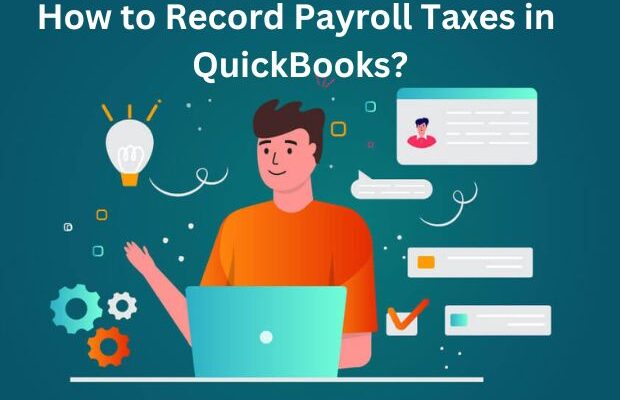
Quickbooks payroll is essential for the Quickbooks bookkeeping programming. It helps to manage all aspects regarding employees, like attendance, compensation given to employees, employee salary scale, deductions, etc. It also helps to manage inventory and human resources. Quickbooks payroll fulfills all the requirements to manage a small business. Among all applications, QuickBooks is one of the best approaches to recording all payroll taxes. Payroll accountants can make employee salary entries to maintain records and process paychecks easily. Payroll taxes ensure that all processes use applicable laws and policies of concern to the government. If you want to record payroll taxes, first of all, you want to know about QuickBooks.

Quickbooks accounting software is the most usable accounting software for recording payroll taxes QuickBooks is fully developed for working on all accounting tasks in one location. QuickBooks accounting software is easily integrated with other software like tracking expenses, monitoring financial analysis reports and bank records, dragging invoices, etc.
Quickbooks is the best option to enter payroll and a journal entry can also be created to record these payments. In QuickBooks several methods to connect payroll taxes like manual data entry filing, paying, QuickBooks Desktop, QuickBooks Online, automatic tax calculation, integration with tax filing services, account, and tax professional assistance Quickbooks PayPal services, QuickBooks payroll services, through third-party, automatic, etc the specific method you can use depends on the various factors like comfort of use, budgets and several employees and type of business. mainly manual methods are used. for that reason, we discuss only manual methods. If you want to record payroll taxes we simply discuss them and follow the given steps to record taxes in QuickBooks-
Step1 QuickBooks Payroll taxes record for before period-
- First, you want payroll software
- Then complete your software setup
- Go to the “left menu” and click on “new”
- And hit next click on the “taxes” option
- From the available preference you have to choose the “payroll taxes” option
- Select “prior tax history” from the available options
- Now click on “add payment option”
- Fill in all the demanded information about payment like cheque number, bank name, etc.
- To the end process click on the “ok”
Step 2 Payroll taxes record for the current period-
- First, you want payroll software
- Then complete your software setup
- Go to the left menu and click on the new
- And hit next click on the taxes option
- From the available preference you have to choose the “payroll taxes” option
- Select record payment
- Goto others
- Enter date
- Fill in all the demanded information about payment like cheque number, bank name, etc.
- Click on approve
- To the end process click on print
Verify the records
After completing all entry must verify the recorded payroll taxes and follow some steps to check –
- Go to “New“.
- The first thing you have to do is to go to the “Left Menu” and choose the “Reports” option.
- Click on the “All report”.
- Next, choose “Manage Payroll”.
- Select the “Payroll Taxes” Payments Report.h
- Confirm Your Payroll Taxes Recorded.
Technical Help: QuickBooks Finance Backing helps clients with specialized issues, programming establishment, refreshes, and investigating. This could involve addressing errors, connectivity problems, and software glitches.
Usage Guidance: The support team offers guidance on using the software’s features effectively. This could include setting up employee profiles, entering salary information, configuring tax settings, and generating payroll reports.
Tax Compliance: Payroll taxes can be complex, and QuickBooks Payroll Support helps users understand and manage their tax obligations. They can provide information on tax rates, deductions, and other related compliance matters.
Direct Deposit: QuickBooks Payroll supports direct deposit functionality, allowing users to pay employees electronically. The support team assists in setting up and troubleshooting this feature.
Updates and Upgrades: The support team informs users about software updates and upgrades, helping them keep their payroll software current and benefit from new features and improvements.
Data Security: Payroll data is sensitive and confidential. QuickBooks Payroll Support helps users maintain the security of their data, offering advice on best practices and data protection measures.
Training: New users may need training on using QuickBooks Payroll effectively. Support administrations could incorporate internet-based instructional exercises, client guides, and instructional meetings to assist clients with getting to know the product’s highlights.
Troubleshooting: In case of software errors or issues, the support team assists users in diagnosing and resolving problems. This could include strolling clients through bit-by-bit arrangements or giving far-off help.
Consistency Updates: Finance guidelines and duty regulations can change. QuickBooks Payroll Support keeps users informed about any changes that could impact their payroll processing, ensuring compliance with relevant laws.
Customer Service Channels: Support is typically offered through various channels, such as phone, email, live chat, and online forums. Clients can pick the strategy that suits them best to look for help.
Summary
In simple words recording payroll taxes in QuickBooks keeps a clear record of taxes you need to pay when you employee. It helps to stay organised Pay the right amount.
Throughout this, you can easily calculate the net salaries of your employees and handle all deductions like holidays and extra earnings like overtime bonuses because QuickBooks provides this feature to us. Make sure all the tax documents are correctly updated and all the billing information is correct. To get more visible to record, update the journal ledger, and track and monitor paid leaves or unpaid leaves of employees, the user also has the option to calculate fare deductions and overtime. For small business owners who don’t want to spend all day doing accounting. If the employer was going to pay the taxes directly, then a payroll tax account would be used in place of the checking account entry.











